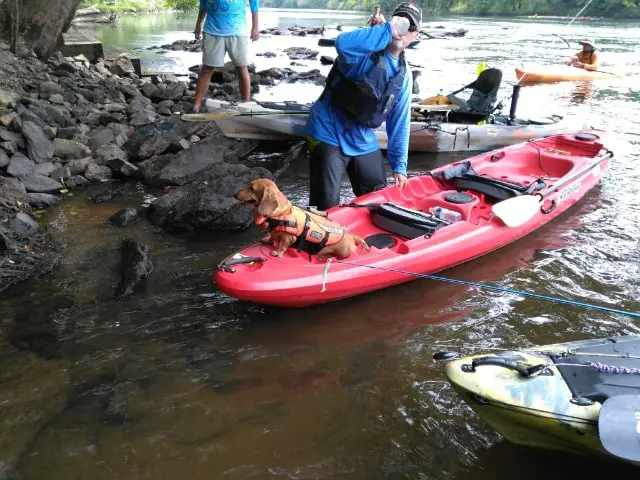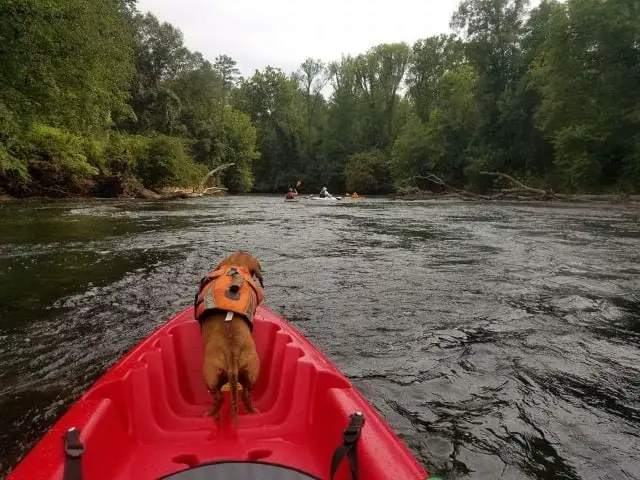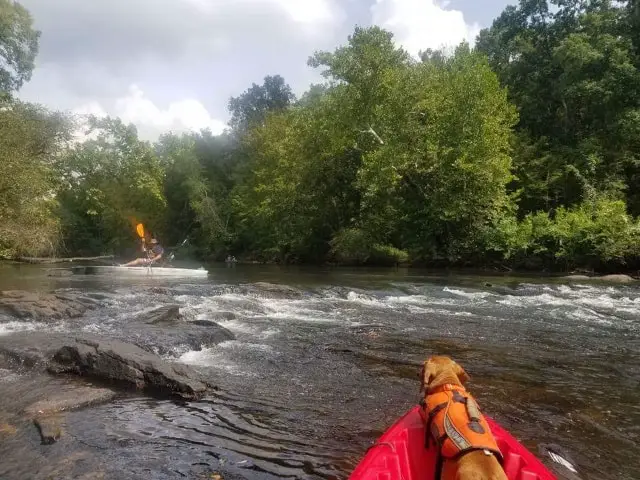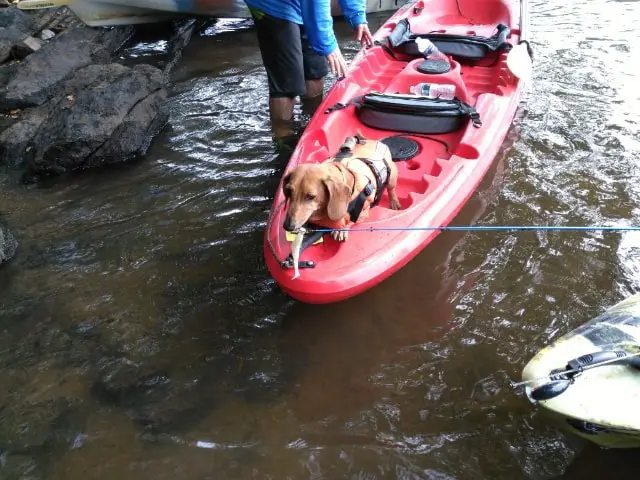
Going kayaking with your dog takes a lot more planning and consideration than it may seem. Although once you get out on the water, it may seem to be a carefree experience, there is a lot of forethought that must go into ensuring a safe and enjoyable experience for both you and your pup.
What are the main things to consider when taking your dog kayaking? Some of the most important aspects to consider are your dog’s level of comfort with the water, getting your dog used to the kayak before taking it out on the water, appropriate gear, type of kayak, and, of course, the breed of your dog.
In order to create the best possible experience for you and your dog on your kayaking trip, you need to start preparing far ahead of time. You need to make sure your dog is comfortable with being in and around the water, used to the kayak (and the proper design of kayak to begin with), and actions you need to take to create a safe and positive environment for your dog.
Training Your Dog for the Kayak
Spending time in the wilderness with your pup should be a relaxing experience. Nothing but you and your bud and the calming sounds of nature. The only thing that could ruin it is your dog not being very comfortable with the water, the instability of the kayak you’re using, or both.
In order to avoid the possibility of getting flipped by your dog getting spooked by any sounds or by the instability of the kayak, you’ll have to acclimate her to the sounds, look and feel of the water and the feeling of being in and around the kayak. Some key things to keep in mind are that you want to create positive associations with water and a neutral or positive environment in the kayak.
You can do this by generously giving your dog treats and affection while in or near the water, and even incorporating play with some of her favorite toys. A sneaky way to get her to go in is by tossing one of her balls or other toys into a shallow body of water so that she is mostly unaware of the fact that she’s splashing through the water – and having fun doing it!
Your dog doesn’t have to particularly love being in the kayak. Truly, it should be not much different of an experience getting into the kayak than getting into a car or walking down the street to the park. The main goal is to create such a comfortable experience and confidence in your dog that she really doesn’t notice the difference in the environment as long as you’re present.
Get Comfortable With the Water
Of course, because your kayak will be on the water, your dog will need to be able to maintain a calm demeanor and even enjoy being in or near the water. If your pup is one of those that shrink at even a gleam of light on the water’s surface, going kayaking with your dog is not a good idea. At least, not until she is able to be comfortable with the instability that comes with being in the ebb and flow of the water.
Ideally, owning your dog from a young age gives you time and ample opportunity to properly socialize and expose her to all sorts of stimuli. If you are lucky enough to have a young puppy and intend to take her kayaking with you someday, introduce her earlier to the water early. This way, she is exposed to water over an extended time and is given many opportunities to associate the water with rewards and positive events.
For older dogs that have an aversion to the water, you need to focus on creating positive experiences:
If your dog is fearful of the water, you will need to neutralize this fear and slowly replace the negative reaction with positive ones. To do this, you need to first create a neutral situation with the dog with water nearby. As she becomes more indifferent to water, slowly integrate rewards and games with these experiences.
It’s also been suggested to work on your dog’s fear by introducing her to shallow water by using a kiddie pool. When choosing this option, make sure to use a non-skid surface in the pool, so your pup doesn’t fall and introduce any type of negativity to the circumstance. Water bodies to introduce her to need to be still water, so she’s free to walk in on her own instead of having to dodge a wave.
Get Your Dog Comfortable With the Kayak
Obviously, your dog will need to be comfortable with the kayak! Even for a water-loving dog, this will be a pretty hefty task that you need to work on over a long period. The movement of the kayak on the water will likely scare your dog, young or old, as she is not in control and unable to gain any footing on solid ground to stabilize herself.
This effect will be even greater if the kayak is still unfamiliar to your dog. The combination of sights smells, imbalance, and the novelty of the kayak will be far too much and amplify any fear your dog may have.
Give your dog ample opportunity to familiarize herself with the kayak on her own. This will help her establish confidence in not only approaching the kayak but also remaining in proximity by her own choice. Have the kayak in an open, accessible place to your pup – perhaps in the backyard, for example – so that she can approach and investigate it whether you’re present or not
You will need to make sure that the kayak is secure, however, so that your dog doesn’t accidentally knock it over and scare herself. Joe Robinet, a popular YouTube Entertainer and avid outdoorsman, used some of the following techniques when training his dog Tripper to get out on the water:
- Feeding in kayak
- Practicing commands near the kayak
- First time out on the water, have dog leashed or in a kennel to prevent any jumping out and inadvertently creating a negative experience

Learning to Launch Your Kayak With A Dog
Once you have established the groundwork in getting your dog comfortable with both the water and your kayak, you will need to practice launching the kayak with your dog inside. Despite prior training, this step may still be difficult because of the abrupt movements associated with pushing the watercraft off the shore and into the water.
American Paddler suggests positioning your kayak as close to the water as possible before launching, and encourage your dog to climb in. This will help with two things: reducing the amount of time your dog is having to spend in the kayak loudly and shakily scraping over the ground and make it easier for you to push yourself in.
You’ll be pushing from the inside of the boat because you absolutely do not want to push your dog into the water by herself. Even if it is just for a brief second before you hop in with her, watching you push her away into the water may be enough to spook your dog enough to try and hop out.
You can even let your dog swim around in the water before getting into the kayak to get rid of any excess energy, reducing anxiety and the chance of her leaping out. Once out on the water, simply let yourselves float for a bit to allow your pup to get used to the feeling of floating before introducing even more movement.
How to Position You and Your Dog in the Kayak
One of the worst things that can happen for you and your dog on the water is having your kayak capsize. This is something that could – depending on your dog’s sensitivity and level of acclimation to the water – potentially traumatize your dog and make her not want to return to the water, kayak, or not.
Your best defense against this type of accident is making sure to position yourself and your dog appropriately in the kayak. No matter what, you’ll want to make sure that yours and your pup’s weight are equally distributed. Depending on the type and size of your kayak (and size of your dog), this may mean positioning yourselves equidistant from the center of the kayak or you on one side and your dog in the middle.
Experiment with the balance either on land or in shallow water before you get out there.
You should also avoid getting your pup too excited while out on the water to prevent her from getting up and walking around or trying to play. Too much movement is just as bad as improper balance. You can keep her calm by talking to her – not in your high-pitched play voice – and petting her if she seems to be getting uncomfortable.
What Not to Do When Kayaking with a Dog
A few things to avoid doing when kayaking with your dog are:
- Avoid Spending the Whole Ride Nearshore. Spending too much time at the shoreline will pose just as much of a risk as overexciting your dog when out on the water. This is because any little critters that may be running along the shoreline, like a bird or squirrel, may catch your dog’s attention and cause her to either become frustrated from excitement or jump out in pursuit.
- Never, ever, ever tie your dog to the kayak. Regardless of the behavior of the water that day, no matter how calm it may seem, there is always the risk of your kayak getting flipped. If this happens and your dog is tied to the kayak, you’ve put your pup in a situation she may not come out of.
- Don’t forget to bring water! Just like us, being out on the water intensifies the effect of the sunshine. Not only will it heat you up, but it will eventually dehydrate you if you don’t keep up with your water intake. Look out for your pup by making sure she has a couple of laps of water every now and then.
- Push or pull your dog into the water. No matter how badly you want your dog to love the water, you should never push or pull her into it. It doesn’t matter if it’s a lake, a river, or the ocean, taking the choice away from your dog to get into the water will likely frighten them, and all you will have accomplished is creating a traumatic experience for her.

The Best Gear to Bring Along when Kayaking with a Dog
There are a few things you need to check off the list before taking off for your kayaking trip. These items will ensure a safe, comfortable, and enjoyable trip for both you and your pup.
Life Vest
Not all dogs will know how to swim, much less enjoy it. Although it is instinctive for your dog to paddle in the presence of water, don’t count on it. Give your dog a little assistance in safety by providing a life vest for her, especially for smaller breeds that can get easily swept away.
When purchasing a life vest for your dog, make sure that you buy one that is rated for your dog’s size. I recommend this life vest on Amazon because it is affordable, has reflective strips, has a rescue handle, and comes in 8 colors (including 2 camo colors).
Dry Bag With Treats
Obviously, you’ll want to bring treats! What is a kayaking trip without a little snack for both you and the pup? The treats will work for you as a tool as well in enhancing the positivity of the experience for your dog. Being in the kayak should be a fun time for your dog, not a chore. Help her to look forward to it by providing some incentive!
Chew Toys or Long-Lasting Treats
Even a dog who is comfortable with the water can get bored after a while. Give her the option of having a treat or toy to stay occupied while you’re enjoying yourself. Especially if you’re going to have a longer trip. This also helps to create and enhance positive associations with being on the kayak.
Blanket or Cushion
You’ll want to bring along either a blanket or some type of cushion which can function as a bed (or you can just bring a dog bed you don’t mind getting wet). This is so your dog can have somewhere comfortable to sit rather than scratching and slipping around the flooring of your kayak.
Additionally, having the familiar scent of a blanket or pad from home may help to keep your pup come when out on the water.
First Aid Kit
Of course, for both yours and your dog’s safety, you should always bring a first aid kit along with you. Consider including styptic powder (Amazon) in your first aid kit in case your dog’s nails get snagged on anything in the kayak.
Some medical considerations to know ahead of time are the overall physical condition of your dog. Older dogs with conditions such as arthritis should probably not be taken on the water, as it may be very difficult for them to keep balance on the kayak if they stand at all, and the hard surface of the floor or seats will be difficult for their joints to cope with.
Additionally, make sure to keep up with vaccinations, particularly leptospirosis and heartworm. Leptospirosis is a bacterial infection your dog can pick up primarily in areas with still water since it’s passed via animals’ urine. Protecting your dog from heartworm is essential if you’re active in any water sport because of the typical presence of mosquitoes, which carry the disease, near water bodies.
For a run-down on all the kayaking gear that I recommend, click here!
Best Kayaks on the Market for a Canine Companion
As you may well know, there are many different types of kayaks, and they may not all be suitable for you and your pup. The type of kayak you choose will mainly influence the weight distribution and positioning of you, your dog and your belongings on the watercraft.
Some things you need to consider when choosing a kayak for you and your dog are
- Size of your dog
- Weight of your dog
- Length of the kayak
- The kayak’s weight limit
- What type of water you’ll be taking the kayak into
- The types of activities you’ll be engaging in
- Design of the kayak: individual cockpits vs. one large sitting area
These aspects will help you determine the kayak that will be able to handle any sort of movement and weight the water, you, and your dog will be introducing to the kayak. Choosing the proper watercraft will keep you safe and having fun. Here are some of the best types of kayaks for you and your pup.
Sit-On-Top
The sit-on-top kayak, also known as the “open-deck design,” is one of the most stable and roomy designs. It’s particularly great for you and your dog because it will not sink or fill up with water if you or your dog accidentally rocks the boat.
The main thing to consider here is your dog’s personality. The openness of this design does pose a risk for those dogs that are easy to spook or excite. Unless you don’t mind your pup hopping out to take a dip in the water, you may want to consider a different design.

Closed Cockpit
With this design, you and your dog both have your own individual compartments on the kayak. This designates an equal amount of space for both you and your pup and maybe the best option for those who need to pay extra attention to the weight distribution. For instance, heavier dogs could do well with this model as it ensures they’ll stay in one space on the kayak and avoid shifting their weight around too much.
This will also help any dogs that may be a bit more excitable, as the walls of the kayak are higher and so discourage behaviors such as leaping out of the watercraft.
On the other hand, kayaks with large single cockpits could still work well for owners with medium-sized breeds. It will still offer the same benefits as those mentioned above. However, you will have to share your space with your furry pal. If you don’t mind this, it’s not a big deal. This feature could be a benefit rather than a disadvantage if your dog prefers being close to you.
Tandem
This is essentially another version of the cockpit design. The only difference is, instead of you and your dog getting to possibly face each other with the standard cockpits, you’ll have to sit behind your dog in order to steer comfortably. Sitting behind your dog also helps to more easily supervise your pup.
Best Dog Breeds for Kayaking
If you’re not yet a dog owner and are looking specifically for a dog breed that’s best to go kayaking with, you’ll want to choose a breed that is very keen on water. A kayaking trip will end before it even begins if your dog cannot be trained out of a fear of water, or if your dog is not fit to swim.
Some traits to consider in choosing the right breed for you are your dog’s weight, body structure, temperament, and size. It is best to avoid heavy breeds like mastiffs because their weight will make it difficult to strike a balance between you two on the kayak. Also, if your dog does decide to get up and walk around on the kayak, this poses more of a risk of capsizing than, say, a sporty retriever breed.
If at all possible, consider choosing a canine kayaking partner with their body structure in mind. Dogs with a stockier build may have a tougher time trying to swim if they end up in the water somehow. Imagine an English bulldog or corgi – it will be far more difficult for them to swim than a Labrador retriever.
The temperament of your dog matters in that you want to avoid having a dog that’s too high-strung out on the open water for too long. Having to sit in one place for extended periods or any stress they may feel from any water-related issues may add to their anxious personality.
Water-Loving Dog Breeds
There are many dog breeds that are very well-known for their propensity to water. One thing to keep in mind, though, is that your dog’s breed is not an end-all-be-all to whether she likes the water or not. Any dog, even the tiniest, most hydrophobic of them all, can be taught to love water. The importance of the breed is that the body structure and temperament tend to predispose the dog to enjoy the water.
Some of the most well-known water-loving breeds are:
- Labrador Retriever
- Chesapeake Bay Retriever
- Portuguese Water Dog
- Border Collie
- Brittany Spaniel
- Springer Spaniel
It’s important to recognize what these breeds have in common. They all have a very lean build. None of these breeds are very heavy – in fact, the heaviest any of them can get on average is about 75 pounds. Most of them also have fairly short coats, all very light in nature as well. The longest coat of this grouping would be that of the Portuguese water dog, and even their coat is more fluffy and textured than long.
There are two advantages to these coat types. The shortness of their coat will help to let the waterfall off them easier when coming out of the water, and flow around them much smoother when swimming. This will help your dog to dry off faster and also to not be weighed down if she wants to hop in for a swim.

Your Experience is Up to You
At the end of it all, keep in mind that your canine kayaking experience is going to be up to you. Getting your dog comfortable with the kayak, the water, and ensuring that her physical condition is up-to-par with such a physically-demanding activity is not solely determined by breed.
Yes, you will have greater success or a marginally easier time choosing a breed that is predisposed to like water. However, your dog’s breed does not control any instances in your dog’s life that may incline her to be more nervous or have a harder time adjusting. Additionally, any dog that is used to living a relatively stationary life will have to be given time and patience when learning to be comfortable on a strange floating thing.
It is ultimately your responsibility to keep you and your dog safe. That responsibility entails being as prepared as possible for anything that may come your way. A majority of this preparation is preventative in nature and largely based on your research ahead of time: Know what type of kayaking experience you’re aiming for and choose the appropriate kayak design with you and your dog in mind.
Canine kayaking is one of the most fun activities you and your pup can do together. It is meant to be a relaxing time to bond and return to nature with your best friend, so make sure to take all the necessary precautions in order to create the best getaway possible.

